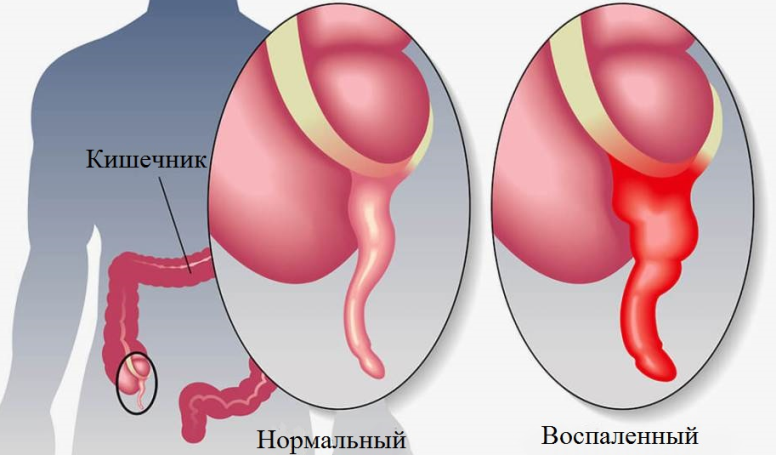Many people heard about appendicitis, but not everyone knows where it is and what signs of inflammation. Read more in the article.
Contents
- What is appendicitis?
- On which side is the appendicitis in humans: scheme, description
- How acute appendicitis hurts in adults: symptoms
- Signs of acute appendicitis in children
- APDENDICITE Chronic: Signs
- What can be the temperature for appendicitis?
- Can appendicitis give to the left, can the stomach hurt on the left?
- Can there be appendicitis on the left side: on which side of the scar from appendicitis?
- Types of appendicitis: List
- Than the appendicitis is dangerous: complications
- What to do with suspicion of appendicitis at home?
- How much do they lie in a hospital with appendicitis?
- Video: Appendicitis: How to determine appendicitis, signs of appendicitis, on which side of the appendicitis?
About 10% People came across in their lives with such a concept as appendicitis. Those who did not deal with the disease personally heard about him from his relatives or friends. From this article you will learn what it is, what signs exist, how acute appendicitis hurts and how it is dangerous. Read further.
What is appendicitis?
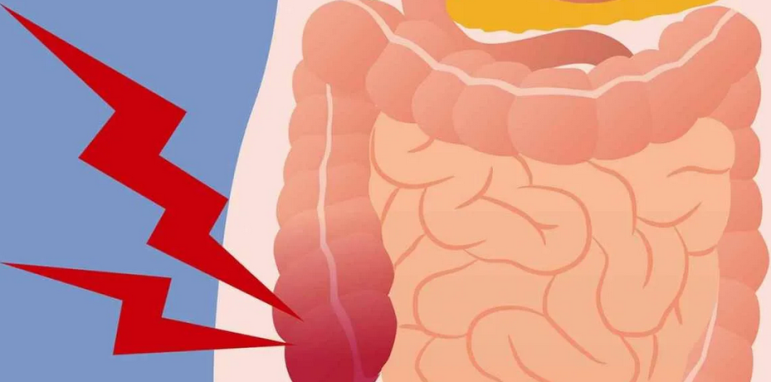
Appendicitis is a fairly common disease of the digestive system, which occurs as a result of inflammation of the appendix of the cecum, called appendix. The disease does not give a lot of time for thought and requires immediate surgical intervention.
The absence of timely treatment is fraught with serious complications, up to death. Such cases are rare, and the disease is good to treat, the main thing is not to delay. According to statistics, women are slightly, but more susceptible to inflammation of the appendix than men. As for age, it can be noted that at the risk zone children 3 to 17 years old And young people from 18 to 30 years old.
On which side is the appendicitis in humans: scheme, description
Most people know that appendicitis is on the right side. But if you ask a person where exactly the appendix is \u200b\u200blocated, he is likely to be confused and thought. Everyone indicates different parts of the abdomen, and over 30% People answer this question erroneously.
To figure out exactly where the appendicitis is, it is important to understand what the appendix of the person is, and where it is located. Here's a description:
- In the lower right of the intestine, the process branches from the cecum, about the diameter of about 10 mm.
- Its length varies from 2 to 20 cmon average in an adult - 10 cm.
- Below the diagram shows which side the appendicitis in humans is on.

Surprisingly, the appendix performs a protective function in the human body, being part of the immune system. It is involved in the production of bacteria intestinal microflora. In a normal situation, the contents of the intestine do not fall into the process, otherwise there is an inflammatory process called acute appendicitis.
How acute appendicitis hurts in adults: symptoms
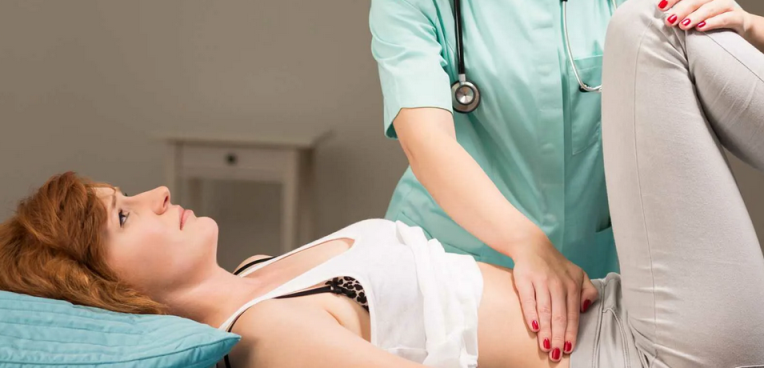
Often with acute appendicitis, both in adults and in children, sudden pain occurs. Initially, the patient feels severe pain in the navel or stomach. After that, the pain is not delayed in one place, but moves from one part of the abdomen to another. This can be felt not only on the right, but also to give to the left side, to the ribs, to the anus. Only a few hours later it is localized in the right side, between the navel and the right iliac bone.
Additionally, the following symptoms may be accompanied by the disease:
- Nausea and vomiting
- Pain when pressed on the stomach
- Problems with a chair
- Fever, fever
- Aggravation of pain during cough
There are cases with ambiguous symptoms. The patient feels aching, unimportant pain, while body temperature is normal. Diagnosis with such symptoms is difficult. However, an experienced doctor will be able to perform it easily. Therefore, when any pain in the abdomen occurs, do not self -medicate and call an ambulance, especially if there are more severe concomitant symptoms in the form of an increase in temperature, vomiting, diarrhea, etc.
Signs of acute appendicitis in children
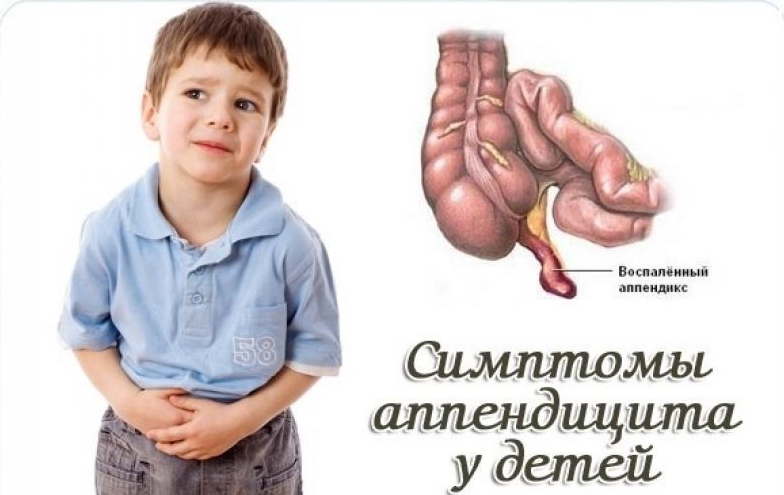
Unlike adults, children tolerate appendicitis harder. In this case, there are difficulties with diagnosis due to the ambiguity of symptoms. According to statistics, children up to 3 years They get sick much less often. Moreover, not every child will be able to clearly tell about his ailments, so you should be careful about the child’s complaints to describe the symptoms.
When is it worth a guard and immediately seek medical help? What are the signs of acute appendicitis in children? The doctor always suspects the presence of appendicitis if the child has the following:
- Pain and colic in the stomach.
- Lack of appetite.
- Nausea, vomiting, stool violation.
- Increased body temperature.
- White plaque on the tongue.
- Lack of activity and legs pressed to the stomach. For example, the baby tries to move less due to pain.
In this case, you do not need to hesitate and hope that the disease will retreat itself. Do not resort to folk medicine to miss precious time and avoid serious complications. It is also worth noting that for schoolchildren and preschoolers from 3 years old The poor -intensive nature of pain and the gradual development of the inflammatory process are characteristic. The disease is disguised, and most importantly, recognize it in time.
APDENDICITE Chronic: Signs

In addition to acute, there is such a thing as chronic appendicitis. For a long time, the doctors questioned the existence of this form of the disease. Today this statement is no longer disputed. But chronic appendicitis is extremely rare - approximately in 1% of patients. The cause of the occurrence of the disease may be an acute appendicitis, which is not removed surgically.
Symptoms of a chronic disease are not as obvious as in acute inflammation of the appendix, so diagnosis causes complexity. Most often, the patient notes the following signs:
- Periodic aching, sluggish pain in the area between the navel and the right iliac bone.
- Problems with digestion, severity, bloating, constipation, diarrhea.
- In the evening, body temperature.
- Increasing the level of leukocytes in the blood.
To make a diagnosis of chronic appendicitis, doctors often have to first exclude other diseases of the digestive system with similar symptoms.
What can be the temperature for appendicitis?
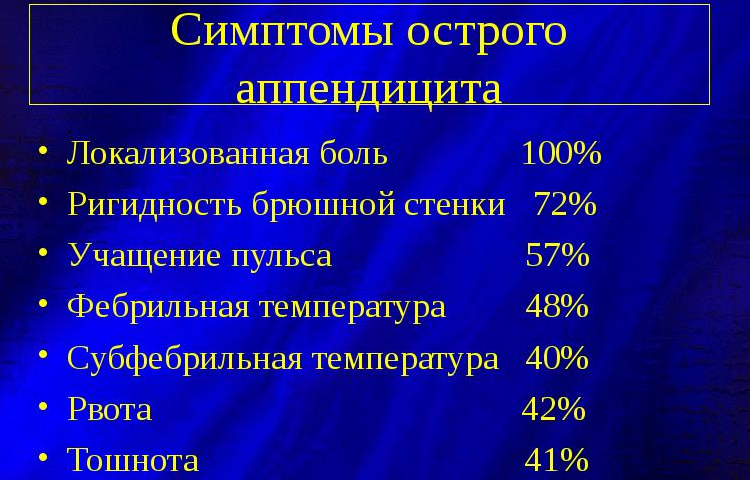
The human body reacts to inflammatory processes by raising body temperature. What indicators are with appendicitis? It is worth noting the following:
- In rare cases, the temperature of the patient with acute appendicitis remains normal.
- As a rule, the development of the disease is accompanied by increased figures on the thermometer.
- On average, varies within 37.5 - 38 degrees, but can reach higher marks in critical situations.
Therefore, with an increase in body temperature and abdominal pain, you should call a doctor or urgently go to the clinic.
Can appendicitis give to the left, can the stomach hurt on the left?
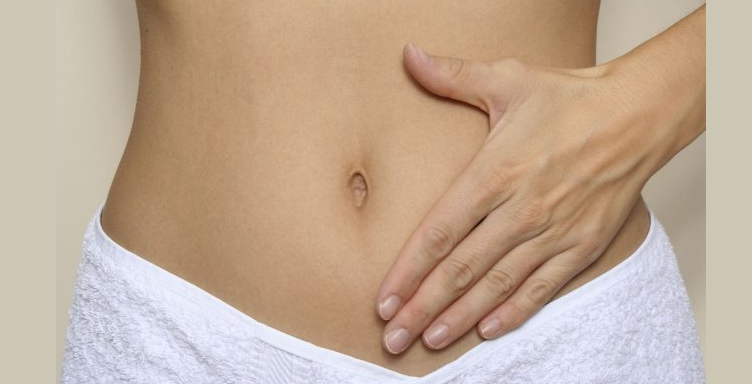
Most people have an appendix in the right lower abdomen. But on which side the pain arises, depends on the structure of the intestine itself. There are several types of appendix location in the peritoneum. He branches out of the cecum and can be directed in different directions:
- Towards the small pelvis, borders on the genitourinary system
- Inside the loops of the intestine
- Towards the front wall of the peritoneum
- Towards the liver or gall bladder
- Behind the cecum
- The left -sided position of the appendix
The different location of the process does not allow identifying unambiguous symptoms, since pain can be given not only to the right. Therefore, appendicitis can give to the left and can hurt the stomach on the left.
Can there be appendicitis on the left side: on which side of the scar from appendicitis?

To answer the question: "Can there be appendicitis on the left side?", it must be understood that the left -sided position of the appendix is \u200b\u200bextremely rare. Such cases are more likely to be exceptions. According to statistics, the left -sided position of the process occurs in people with the reverse arrangement of internal organs. The diagnosis of such cases is difficult due to ignorance of the left -sided situation of the process.
The symptoms are the same as in a right -hand position. Accordingly, the scar will be on the left. But in the overwhelming number of cases, due to the rare number of left-sided anomalies, the scar from appendicitis is located on the right.
Types of appendicitis: List
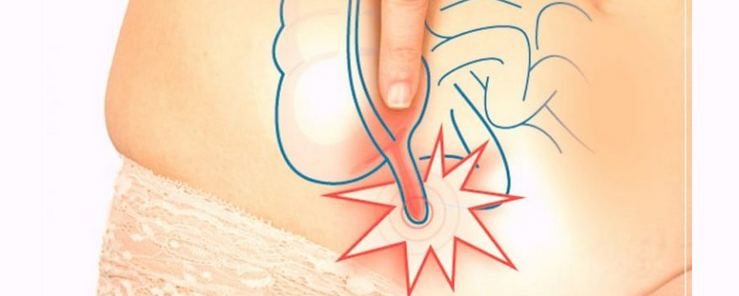
In addition to acute and chronic appendicitis, the following types are distinguished:
- Catarrhal. It is characterized by the unheated inflammation, the absence of suppuration. Only the mucous membrane is hurt.
- Phlegmonous. It proceeds with the formation of ulcers, suppuration and inflammation. Maybe with a perforation and without it.
- Gangrenous. A dangerous type of disease occurs as a result of appendix blood vessels. It can lead to inflammation - peritonitis. It may also be accompanied by perforation.
- Perforative. An extremely dangerous type of appendicitis. With perforation in the appendix, a hole occurs, through which the contents of the process enters the peritoneum. The patient feels severe pain.
Important: Do not try to independently figure out what type of appendicitis you or your child, if complaints about abdominal pain and have other symptoms. It may be dangerous. Urgently see a doctor!
Than the appendicitis is dangerous: complications
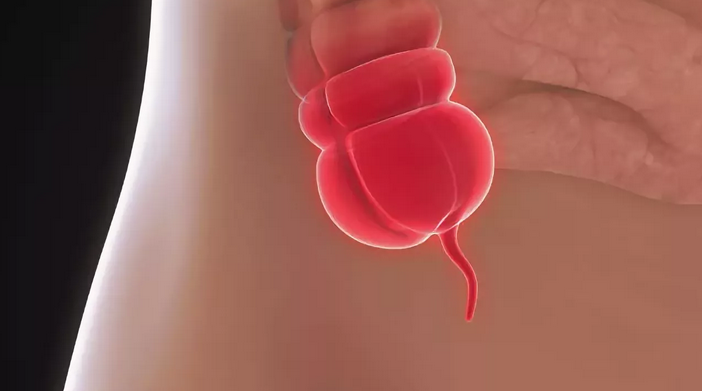
Acute appendicitis requires immediate treatment. This is necessary in order to reduce the risk of serious complications that can be preoperative and postoperative.
Preoperative complications:
- Occur with untimely treatment.
- Most often, the reasons for this are: untimely seeing a doctor, an incorrect diagnosis, a non -standard arrangement of the process.
- The complication may be a perforation of the appendix, which entails abscesses - clusters of pus, which are localized in the pelvis, in the intestines, rarely in the diaphragm area.
- Abscesses cause peritonitis - inflammation of the abdominal cavity, thrombophlebitis of the porous vein of the liver.
- The perforation of the appendix causes difficulties in conducting surgical treatment. In this case, doctors have to not only remove the inflamed process, but also sanitize the entire peritoneum.
Postoperative complications:
- Often often in older people and in patients with weakened immunity.
- In the early stages, after the operation, complications at the site of the cut may occur: bleeding in the peritoneum, a problem with the seams, the continuation of the inflammatory process.
- In the event of an abscess, urgent repeated operations with rehabilitation and drainage of the abdominal cavity are needed.
- At later stages after surgery, suppuration of the wound, the distinction of the seam, fistula, adhesions, and postoperative hernias are possible.
- In the presence of these complications, the patient needs repeated surgical intervention.
If in the postoperative period observe all recommendations, the probability of consequences is significantly reduced. At first after the operation, it is necessary to observe bed rest, restrictions on eating, a ban on lifting weights and physical exertion for three months. All the details of contraindications must be discussed with the attending physician, each case is individual. At the first signs of complications, you should contact the medical institution.
What to do with suspicion of appendicitis at home?
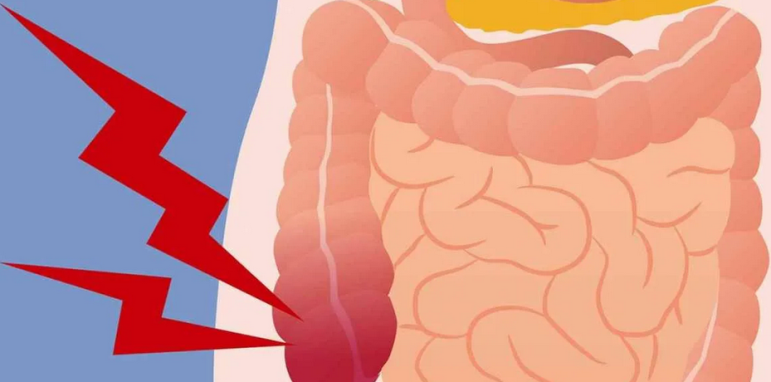
If there are manifestations of acute appendicitis listed above, the main advice is to consult a doctor. The hospital will be able to diagnose by analysis of blood, urine, ultrasound and other studies. What can be done with suspicion of appendicitis?
There are several techniques to check the presence of inflammation in the appendix at home:
- Cough. When coughing, the pain in the right side intensifies.
- Press the sore spot. Here you need to be very neat, with a strong press, you can damage the appendix, which will lead to its gap and complications.
- You need to lie on the left side with elongated legs, with appendicitis, painful sensations become stronger.
Important: Do not forget that self -diagnosis cannot replace the examination of doctors and the necessary tests.
Before a medical examination, it is forbidden to take painkillers, to put enemas, to warm with a heating stomach. A change or absence of complaints from the patient can lead to an incorrect diagnosis.
How much do they lie in a hospital with appendicitis?
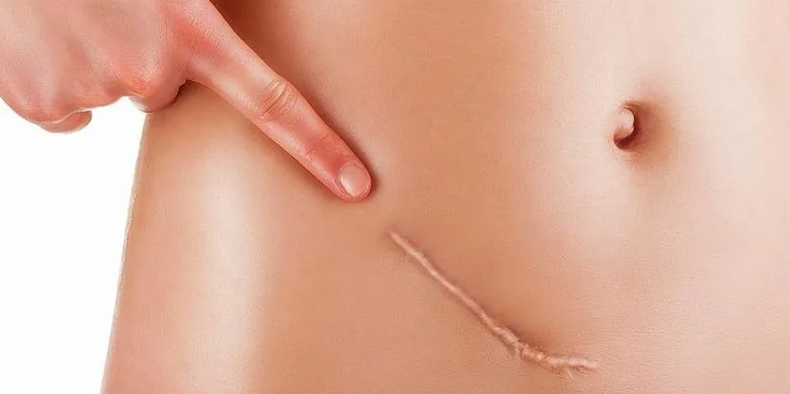
With a modern level of medicine, the removal of appendicitis often occurs laparoscopically, which reduces the period of recovery and finding the patient in the hospital walls. How much do they lie in a hospital with appendicitis? Here's the answer:
- The maximum time in the hospital is 14 days, but more often than 10 days.
The rehabilitation period depends on the features and complexity of the operation. In the case of the complicated postoperative period, staying in the hospital can be delayed even for a month. Appendicitis with a gangrenous process and peritonitis requires a crazy operation and, accordingly, a long period of recovery. The deadline for the patient in the hospital depends on the possibilities of his body.
After discharge from the medical institution, the patient will not be able to immediately return to the previous lifestyle. For some time you will have to adhere to restrictions:
- A person will be able to start work approximately after 3-4 weeks, in the absence of complications, and provided that the work is not physical.
- People with overweight are recommended to wear a special bandage.
- All patients are shown as maximum maximum physical activity, for example, swimming.
- Eating should be in accordance with the diet: it is easily digestible, liquid food. A return to the previous diet should occur gradually.
Compliance with the listed recommendations will avoid improper fusion of the seam, the formation of adhesions and inguinal hernia. Good luck!

